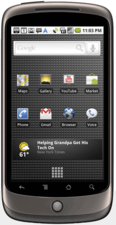Google Mobile Phone with OLED Display and Android 2.1
Google has presented its Android mobile phone to the public. What's special about the Nexus One is the 3.5" touchscreen with an OLED display resolving at 800 x 480 pixels and the newest Android 2.1 (Eclair).
The Nexus One has some advantages over the iPhone. The device is some millimeters flatter and its integrated wireless adapter supports the faster 802.11n standard. Even the display with its 800 x 480 pixels provides a markedly better resolution than the iPhone's 480 x 320 pixels, although Android fans will have to forego multitouch support for the moment.
The device marketed and sold by Google is produced by mobile phone maker HTC, which already has a few Android devices in its repertoire, among them the first Google phone.
The Nexus One will be distributed at first in the U.S. (T-Mobile and Verizon) and England (Vodafone). With a two-year contract, the device should cost under $200 in the U.S., without a service plan, about $530. The Nexus One should become available in Europa in the spring of 2010.
Some data:
- Qualcomm processor QSD 8250 with 1 GHz
- 5-megapixel camera with autofocus, 2X digital zoom, LED flash and ability to capture video at 720 x 480 pixels (20 frames per second)
- UMTS band, HSDPA, HSUPA, GSM/EDGE (in frequency bands 850, 900, 1800, 1900 MHz)
- Wi-Fi 802.11b/g/n and Bluetooth 2.1
- Storage on 512-MByte Flash, 512-MByte RAM and 4-GByte Micro SD card (expandable to 32 GBytes)
- Audio decoders include AAC LC/LTP, MP3, MIDI SMF and Ogg Vorbis
- Video codecs H.263 and MPEG-4 SP
- Graphic formats JPEG, GIF, PNG and BMP
- AGPS receiver, digital compass and sensors for light, proximity and acceleration
- Battery is 1400 mAH and replaceable
- Phone measures 4.7 x 2.4 x 0.5 inches and weighs 4.6 ounces
Subscribe to our Linux Newsletters
Find Linux and Open Source Jobs
Subscribe to our ADMIN Newsletters
Support Our Work
Linux Magazine content is made possible with support from readers like you. Please consider contributing when you’ve found an article to be beneficial.

News
-
Another Linux Malware Discovered
Russian hackers use Hyper-V to hide malware within Linux virtual machines.
-
TUXEDO Computers Announces a New InfinityBook
TUXEDO Computers is at it again with a new InfinityBook that will meet your professional and gaming needs.
-
SUSE Dives into the Agentic AI Pool
SUSE becomes the first open source company to adopt agentic AI with SUSE Enterprise Linux 16.
-
Linux Now Runs Most Windows Games
The latest data shows that nearly 90 percent of Windows games can be played on Linux.
-
Fedora 43 Has Finally Landed
The Fedora Linux developers have announced their latest release, Fedora 43.
-
KDE Unleashes Plasma 6.5
The Plasma 6.5 desktop environment is now available with new features, improvements, and the usual bug fixes.
-
Xubuntu Site Possibly Hacked
It appears that the Xubuntu site was hacked and briefly served up a malicious ZIP file from its download page.
-
LMDE 7 Now Available
Linux Mint Debian Edition, version 7, has been officially released and is based on upstream Debian.
-
Linux Kernel 6.16 Reaches EOL
Linux kernel 6.16 has reached its end of life, which means you'll need to upgrade to the next stable release, Linux kernel 6.17.
-
Amazon Ditches Android for a Linux-Based OS
Amazon has migrated from Android to the Linux-based Vega OS for its Fire TV.

